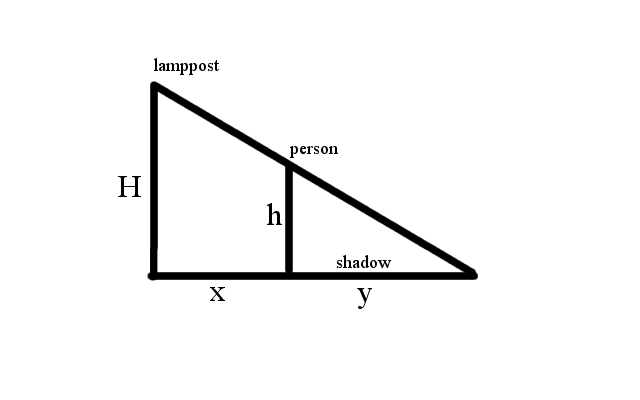Science:Math Exam Resources/Courses/MATH100/December 2012/Question 08
{{#incat:MER QGQ flag|{{#incat:MER QGH flag|{{#incat:MER QGS flag|}}}}}}
• Q1 (a) • Q1 (b) • Q1 (c) • Q2 (a) • Q2 (b) • Q2 (c) • Q2 (d) • Q3 (a) • Q3 (b) • Q3 (c) • Q4 (a) • Q4 (b) • Q4 (c) • Q5 (a) • Q5 (b) • Q6 (a) • Q6 (b) • Q6 (c) • Q6 (d) • Q6 (e) • Q6 (f) • Q7 • Q8 • Q9 • Q10 • Q11 •
Question 08 |
|---|
|
Full-Solution Problems. Justify your answers and show all your work. Unless otherwise indicated, simplification of numerical answers is required in these questions. A light sits atop a post H meters high, and a person of height h, where , walks along a straight line away from the lamppost at a speed of v m/s. At what rate is the person’s shadow lengthening? |
|
Make sure you understand the problem fully: What is the question asking you to do? Are there specific conditions or constraints that you should take note of? How will you know if your answer is correct from your work only? Can you rephrase the question in your own words in a way that makes sense to you? |
|
If you are stuck, check the hint below. Consider it for a while. Does it give you a new idea on how to approach the problem? If so, try it! |
Hint |
|---|
|
Try drawing a picture and labeling with variables. Which ones are constant? Which are changing? |
|
Checking a solution serves two purposes: helping you if, after having used the hint, you still are stuck on the problem; or if you have solved the problem and would like to check your work.
|
Solution |
|---|
|
To get started, we draw a diagram and label with variables. Note that H and h (the height of the lamppost and the person) are constant but x and y (the distance of the person from the lamppost, and the length of the person's shadow) are changing. We relate all the variables in the above picture by using similar triangles:
Cross-multiplying gives
If we differentiate with respect to time, we get
(Recall that H, h are constants, so they aren't differentiated.) The question is asking us for the rate at which the person's shadow is changing, which is the same as the rate at which y is changing, or . So we solve the above expression for .
The rate v that is given in the question is the speed at which the person is walking, i.e. the rate at which x changes, so:
Plugging this into our previous formula, we get
which is the final answer. |
{{#incat:MER CT flag||
}}











